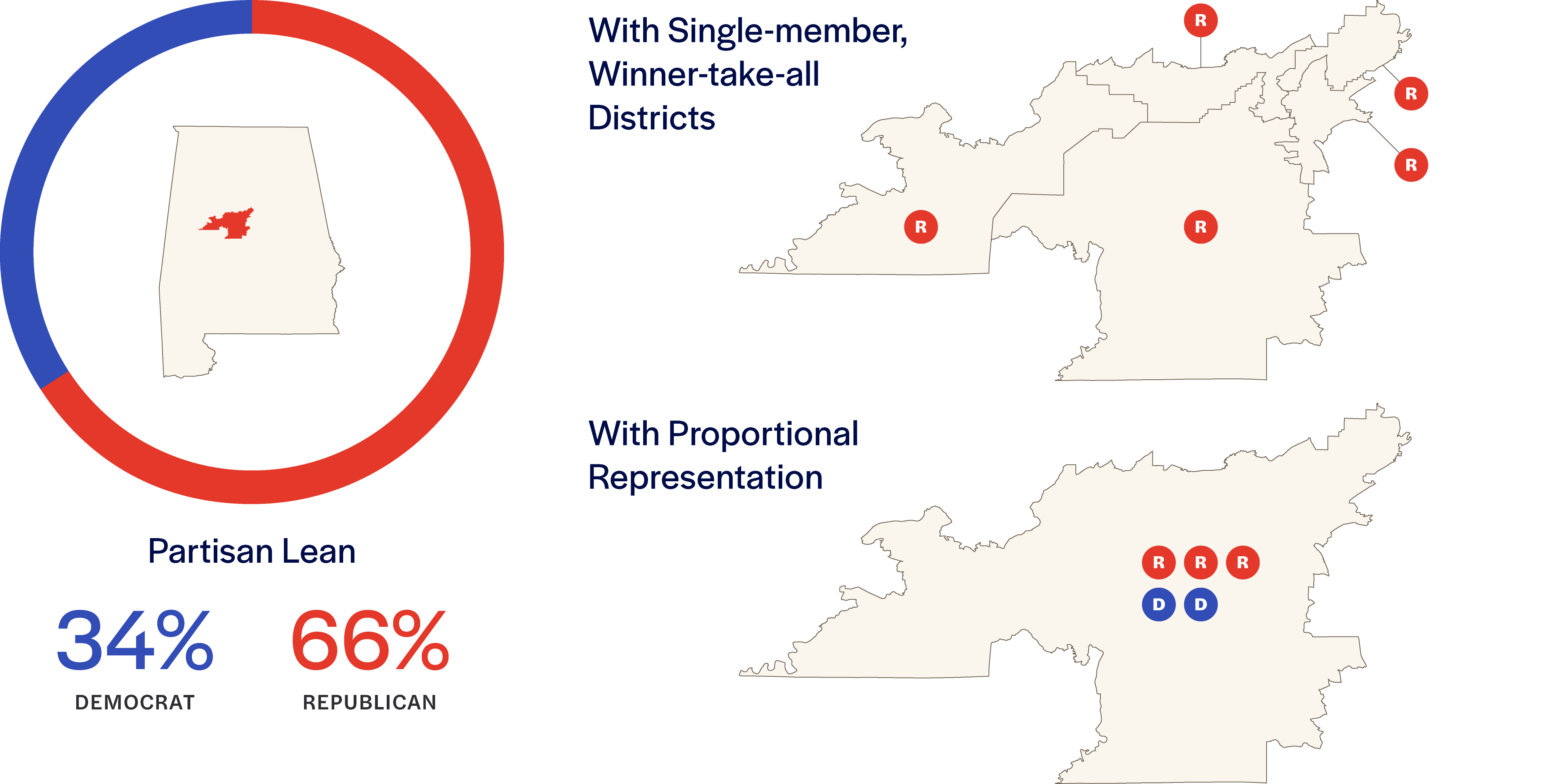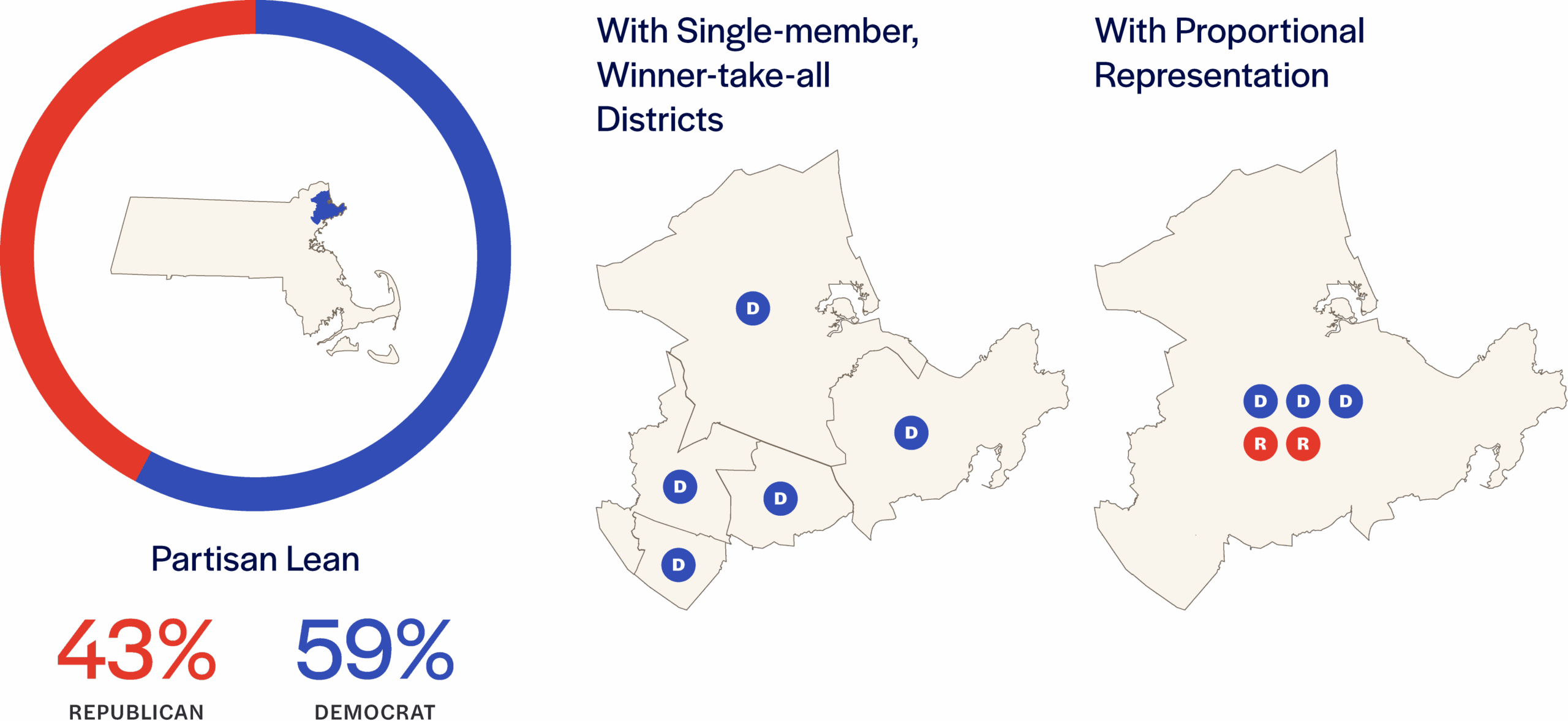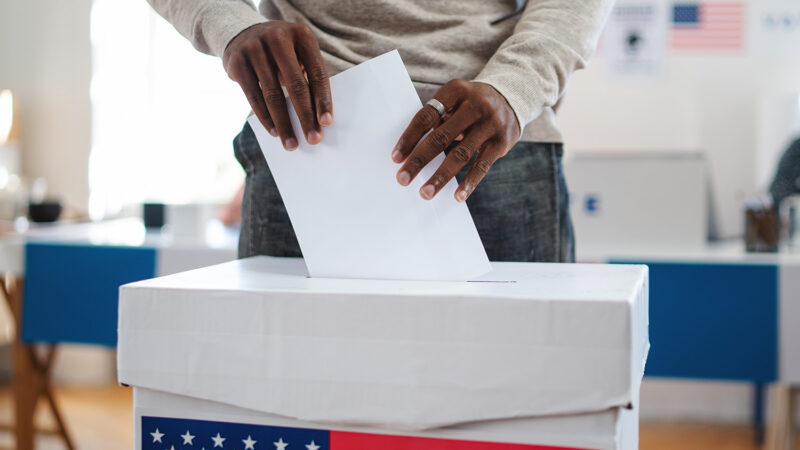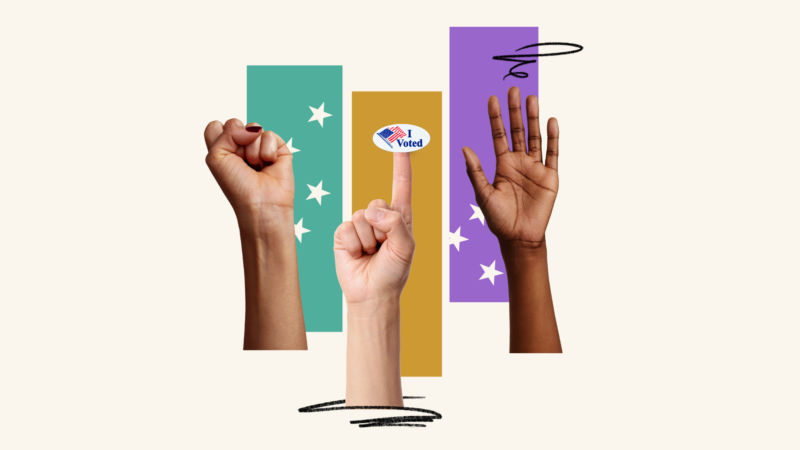What would proportional representation look like in a state legislature?
- August 15, 2024
Proportionally elected legislatures could yield more competitive, representative, accountable, and authoritarian-resistant state politics.

Reform efforts in the United States are often successfully piloted at the local level before gaining traction on the national stage. In the relative absence of federal action, local governments are filling the void by experimenting with electoral systems reform; indeed, dozens of cities and towns have adopted alternative voting systems in recent years.
At the state level, however, methods of electing legislative bodies remain overwhelmingly uniform nationwide, facilitating similar political polarization, dysfunctional politics, and a lack of diverse representation. Considering the outsized impact of state policy on Americans’ day-to-day life — in some ways more directly impactful than federal policy — exploring electoral systems reform for state legislatures is more important than ever.
But what does electoral systems reform mean? What aspects of our elections can be changed to yield better outcomes? At its core, an electoral system is a method for translating votes into seats — how the preferences of voters are translated into electoral results. Virtually all electoral systems fall into two broad categories: proportional representation systems and winner-take-all systems.
Proportional representation is when multiple representatives in each district are elected in proportion to the number of people who vote for them. For instance, if one-third of voters cast their vote for a political party, the party’s candidates win roughly one-third of the seats. Today, proportional representation is the most common electoral system among the world’s democracies.
Read more: Proportional representation, explained Read more: Proportional representation, explained
State legislatures are almost all selected through single-winner elections: voters in a district cast a vote for a single candidate, the candidate with the most votes wins, and all the others lose. This system of elections is winner-take-all — if a candidate wins the most votes in a district, even by a very thin margin, they win 100 percent of the representation. Voters who did not back the winning candidate are represented by someone who may not reflect or respect their views. In state legislatures, this means that each district elects one representative, who is the sole legislative voice for all residents of the district.
Why does this distinction matter? Evidence shows that winner-take-all systems stifle political competition, generate rampant gerrymandering, make state legislatures less responsive to their constituents, and amplify authoritarianism.
In contrast, empirical evidence makes clear that proportional representation can:
- Make elections more competitive;
- Create more choices and better representation;
- Improve government responsiveness and accountability; and
- Strengthen democracy against authoritarianism.
How do winner-take-all elections affect state politics?
Stifling competition
In winner-take-all elections, a candidate can win with only a slight majority (and sometimes just a plurality) of votes. That means districts containing slim but consistent majorities of one party become “safe” for that party, and the general election becomes uncompetitive. In many cases, the opposing party decides not to even field a candidate. Over 40% of state legislative elections in the 2022 cycle were uncontested. And as more and more partisan voters sort themselves geographically — blue voters living in more urban areas, and red voters tending towards rural ones — single-winner, winner-take-all elections will continue to generate more safe districts and insulate candidates from competition.
40%+
of state legislative races in 2022 were uncontested in the general election.
Source: Council of State Governments
Gerrymandering & distorting representation
Single-winner, winner-take-all elections are uniquely susceptible to gerrymandering. At the state legislative level, gerrymandering skews legislatures significantly in favor of the party drawing the maps and away from the actual views of the voters in the state. This means that voters that do not belong to the majority party are routinely underrepresented in state government, their candidates relegated to compete in districts they have no chance of winning. It also means that racial and ethnic minority communities are at particular risk of having their voting power deliberately diluted by unfair maps, preventing them from electing candidates of their choice.
Decreasing responsiveness to constituent concerns
Over the last several decades, state politics have become dominated by national partisan dynamics. Winner-take-all elections reinforce this trend, presenting the two major parties as the only viable electoral choices and locking them into a doom loop of zero-sum gridlock. Particularly in states under one-party control, legislators are likely to prioritize the party’s national agenda instead of being responsive to their constituents’ concerns — for instance, by blocking policies with mass cross-partisan support, like expanding Medicaid — bringing policy out of step with a state’s voters.
Amplifying authoritarianism
Winner-take-all systems make it both easier for authoritarians to take power and harder for them to be unseated once elected — and when authoritarians take power, they weaken democratic institutions. At the state level, we see this manifest in legislatures suppressing voter participation, undermining election administration, and sowing election denialism, all of which threaten the basic functions of our democracy. Attempts to subvert democratic institutions further undermine voters’ trust in our elections and government, which has reached alarming lows.
Benefits of Proportional RepresentationToward proportional representation for state legislatures
While the way we elect our legislative officials may seem like a foregone conclusion, winner-take-all elections are a choice — and states have the ability to choose differently. What would a proportionally-elected state legislature look like, and how would it change politics and governance?
Multi-member districts with proportional representation give more voters a voice.
Alabama state House districts 15, 43, 49, 62, and 73

Massachusetts state House districts Essex County 2, 5, 6, 12, and 13

Making elections more competitive
Proportionally electing multiple legislators from larger, multi-member districts would mean that no district is “safely” red or blue. Instead, all districts would be competitive, with each party vying for seats in proportion to their support. Voters in the political minority of their district — Republicans in cities and Democrats in rural areas, for instance — could win a proportional share of seats rather than being entirely shut out. More competitive elections could increase voter turnout, since more voters would have a chance to cast a vote for a viable candidate who represents their views. Gerrymandering would also be functionally eliminated, since drawing district lines to dilute the voting power of a community or consolidate the power of another is much more difficult when districts proportionally elect more than one representative.
Proportional representation solves partisan skew.
Alabama

Massachusetts

More choices & better representation
Under winner-take-all, the only viable candidates come from the two major parties, and many voters end up represented by candidates whose values and viewpoints do not align with theirs. Proportional representation opens the door for more voters to actually elect candidates from minor parties. This could mean the emergence of new local parties championing state-specific concerns omitted from national political discourse. It would also mean better representation for minority communities, who can more effectively elect favored candidates when district lines aren’t able to undermine their voting power.
Improving responsiveness & accountability
Proportional representation breaks the gridlock and dysfunction that our two-party doom loop perpetuates, opening the door to a more collaborative, effective policymaking process that doesn’t stall when the two major parties reach an inevitable impasse. Legislatures composed of multiple parties and adaptable governing coalitions can govern based on consensus-building instead of defeating the “other side” and create policies that voters actually favor. And increased competition for seats in each district makes it easier for voters to hold politicians accountable at the ballot box.
Strengthening democracy against authoritarianism
A proportional system would counteract the features of our current system that embolden elected officials to undermine our democracy’s essential functions. In a system where political parties that don’t win a majority can still win some representation, partisans are disincentivized from using authoritarian tactics to aggrandize power and subvert the will of voters. And when authoritarians or extremists do win elections, they are limited to the share of representation their votes earn, rather than having the power to capture a disproportionate amount of seats. Plus, renewed opportunities for cross-party collaboration means that diverse multi-party coalitions can emerge to isolate extremist factions and block them from enacting anti-democratic policies. The guardrails against authoritarianism fostered by a more proportional system could help to restore voters’ faith in our elections and democracy.
Pathways to Proportional RepresentationWhat do the pathways to proportional representation look like in different states?
States need to make two main changes to their electoral systems in order to enact proportional representation for their legislature: (1) a proportional voting system, where seats are awarded to parties and candidates in proportion to the votes they receive, and (2) multi-member districts, where in each district elects multiple representatives instead of just one. These changes can be made in a few different ways.
By statute
In some states, multi-member districts are already constitutional, even though single-member districts are currently being used for most legislative elections. In those cases, the state legislature could pass a law establishing proportional voting systems and multi-member districts; in some states, such a law could also be passed as a citizen-initiated ballot measure. Twenty-one states allow citizens to initiate and vote on statutes as ballot measures.
By constitutional amendment
Some state constitutions require the use of single-member districts to elect their state legislature, or only allow multi-member districts in limited circumstances. Those states could adopt proportional representation either by the state legislature passing a constitutional amendment or through an amendment being passed by ballot measure. Eighteen states allow citizens to initiate and vote on constitutional amendments as ballot measures.
By litigation
Proportional reforms can also be adopted at the local and state level through litigation brought under existing state and federal laws. Proportional (or related semi-proportional) electoral systems have been adopted by over 100 localities as remedies for claims under the Voting Rights Act. State-specific Voting Rights Acts similarly allow for the adoption of proportional systems to remedy the harms of vote dilution — several states’ Voting Rights Acts specifically name proportional systems as possible remedies. In 2023, a California Supreme Court opinion recognized the use of proportional systems not only as remedies under the California Voting Rights Act, but also as part of a benchmark to establish liability for claims. In states where minority voters are geographically dispersed, making it difficult or even impossible to improve representation by drawing new single-member districts, curing racial vote dilution through proportional systems opens the door to securing equitable representation.
Americans’ record level of dissatisfaction with our political system, parties, and candidates is alarming — it is also a signal that voters are hungry for change. Proportional representation can help leave behind the dysfunction and polarization stifling our democracy and move toward more competitive, responsive, and representative state politics. Reforming anachronistic electoral systems can be politically challenging, but it is not impossible — and state legislatures have the ability to lead this charge, laying the groundwork for further efforts to improve the systems underpinning our democracy.
Related Content
It can happen here.
We can stop it.
Defeating authoritarianism is going to take all of us. Everyone and every institution has a role to play. Together, we can protect democracy.
Donate
Sign Up for Updates Sign Up for Updates
Explore Careers Explore Careers
How to Protect Democracy How to Protect Democracy







